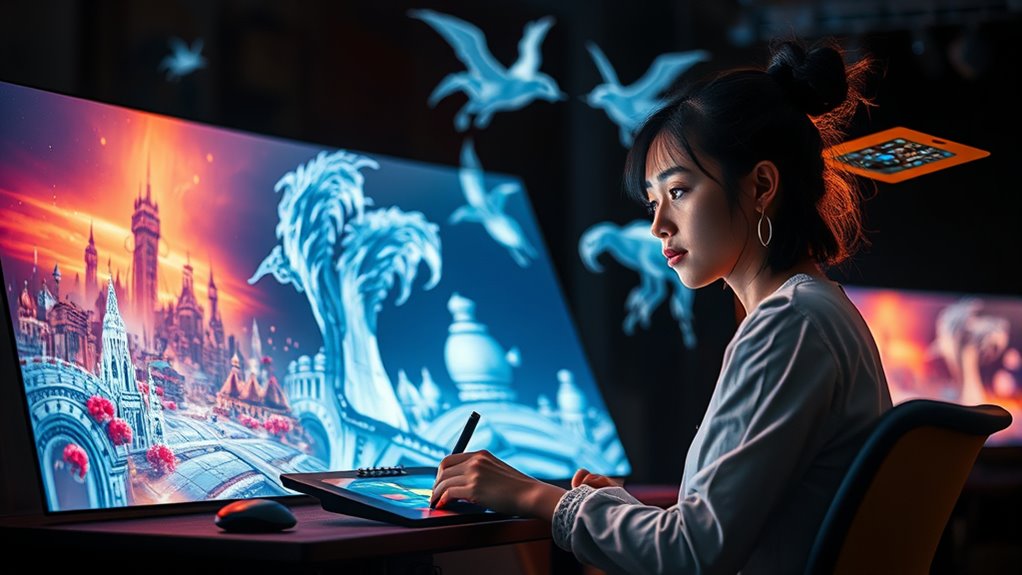AI-generated images are revolutionizing visual storytelling by allowing you to create stunning, realistic visuals quickly and affordably. You can customize images to match your narrative, making your content more engaging and memorable. With AI’s speed and high-quality output, you can tell stories more efficiently and reach your audience more effectively. As AI continues to advance, you’ll discover even more ways to elevate your visuals—stick around to find out how.
Key Takeaways
- AI-generated images enable rapid, cost-effective creation of personalized and compelling visual stories for diverse audiences.
- The near-realistic quality of AI visuals enhances audience engagement and trust in digital storytelling.
- AI tools facilitate innovative visual narratives by allowing creators to design unique, fantasy, or abstract imagery easily.
- Incorporating AI images into campaigns boosts visual content volume, diversity, and emotional impact.
- The widespread adoption of AI visuals is transforming traditional storytelling, fostering new ways to communicate and connect.

As AI-generated images become more prevalent, they’re transforming how we tell stories visually. The rapid growth in this technology means you now have access to an unprecedented volume of images, with over 15 billion produced since 2022 alone. Every day, approximately 34 million new AI-created images are generated worldwide, which comes to about 394 images every second. This explosion of content reflects the increasing reliance on AI tools for visual storytelling, transforming marketing, social media, and creative projects. The AI image generation market is booming, expanding from $299 million in 2023 to an expected $917 million by the end of 2024. When you look at the bigger picture, the entire AI market, including image creation, is valued at $279 billion in 2024 and is projected to reach $1.8 trillion by 2030. Platforms like MidJourney have amassed millions of weekly image requests, showing how deeply users are engaging with AI-driven visuals. This widespread adoption signals a shift where AI-generated images are no longer niche but a dominant form of online content.
AI-generated images are booming, with over 15 billion created since 2022, transforming visual storytelling worldwide.
In social media and marketing, AI-generated or -enhanced images now comprise about 68-71% of visual content used in campaigns. If you’re active on social platforms, especially in the U.S., you’ve likely seen that 71% of shared images are AI-created; in regions like APAC and Canada, this figure climbs to 77%. The quality of AI images has advanced so much that viewers often cannot tell AI faces from real ones, sometimes even perceiving AI faces as more trustworthy. This level of realism is reshaping viewer perception and engagement, making AI images a powerful tool for brands and creators. Communities centered around AI visuals, such as the MidJourney subreddit, have grown to over a million members within a year, reflecting a thriving ecosystem of users exploring and sharing their creations.
AI’s influence on marketing is unmistakable. Over 68% of visual content in social campaigns now incorporates AI-generated images, enabling brands to produce large volumes of tailored content quickly and cost-effectively. This efficiency supports rapid storytelling and personalized messaging, which are vital in today’s fast-paced digital landscape. Recognizing this shift, many organizations are investing in AI skills; about 27% offer AI training to their marketing teams, and 40% have hired AI experts to optimize campaigns. Tools like PhotoGPT allow you to generate high-quality, personalized images in minutes, removing the need for traditional photoshoots and making high-end visuals accessible to all.
Younger demographics, especially Gen Z and Millennials, actively engage with AI-based photo tools—over 70% have used them—highlighting how AI is becoming woven into daily creative expression. AI-generated images in categories like fantasy portraits, headshots, and branding are especially popular, serving both professionals and independent creators seeking innovative ways to express themselves. The rapid growth of AI platforms and online communities signifies a fundamental shift in visual storytelling norms, driven by the ease of access, speed, and limitless creative potential AI offers. As you explore this evolving landscape, you’ll find AI-generated images are reshaping how stories are told, experienced, and shared across the digital world. AI-generated images are now being integrated into various media formats, further expanding their influence and utility across industries. Additionally, advances in realism and quality are making AI-generated visuals indistinguishable from real photographs, which enhances their potential applications.
Frequently Asked Questions
How Can I Ensure Ai-Generated Images Align With My Storytelling Theme?
To guarantee your AI-generated images match your storytelling theme, you should craft detailed, clear prompts that specify colors, emotions, key subjects, and scene context. Use combined inputs like sketches or drawings to guide composition precisely. Refine images iteratively, adjusting lighting, style, and details. Maintain consistency across visuals by aligning prompts with your narrative and using semantic cues, ensuring each image reinforces your story’s mood, theme, and flow.
What Are Common Ethical Concerns With Ai-Created Visuals?
You should be aware that ethical concerns with AI-created visuals include copyright infringement, as these tools often use copyrighted works without permission. Bias and stereotyping can also be amplified, leading to harmful representations. Additionally, AI enables the creation of deepfakes and misinformation, raising issues of trust and consent. To address these, advocate for transparency, responsible use, and ongoing regulation to ensure AI visuals serve ethical storytelling.
How Do I Select the Best AI Tools for Storytelling Projects?
Choosing the best AI tools for storytelling can feel overwhelming, but focusing on key factors makes it easier. You should evaluate image quality, prompt accuracy, and ease of use. Look for tools offering customization and ethical safeguards. Consider your budget, whether you need built-in editing, and integration with other platforms. Prioritize features like style variety and reference image support to craft compelling, consistent visuals that elevate your storytelling to new heights.
Can Ai-Generated Images Replace Traditional Photography in Storytelling?
You wonder if AI-generated images can replace traditional photography in storytelling. While AI images reach impressive realism and can create compelling visuals quickly, they lack the authenticity, spontaneity, and intricate physical interactions that real photos capture naturally. AI excels at enhancing creativity, but for genuine, emotional storytelling rooted in real moments, traditional photography still holds a crucial edge. So, AI complements rather than fully replaces traditional images in storytelling.
How Do I Incorporate AI Images Into Multimedia Storytelling Formats?
You can incorporate AI images into multimedia storytelling by starting with clear input like text descriptions or keywords to guide the AI. Use trained models to generate visuals that match your narrative tone and style, then refine these images through feedback. Finally, embed the polished visuals into your project alongside audio, video, or interactive elements, creating a seamless, engaging story that captures your audience’s attention and enhances understanding.
Conclusion
As you explore AI-generated images for visual storytelling, remember that over 70% of marketers say visuals boost engagement markedly. This shows how powerful AI art can be in capturing your audience’s attention and conveying stories more vividly. By harnessing this technology, you can create compelling narratives that resonate deeply. So, embrace AI tools to elevate your storytelling, making your messages more impactful and memorable—it’s an exciting way to connect in a visually driven world.









